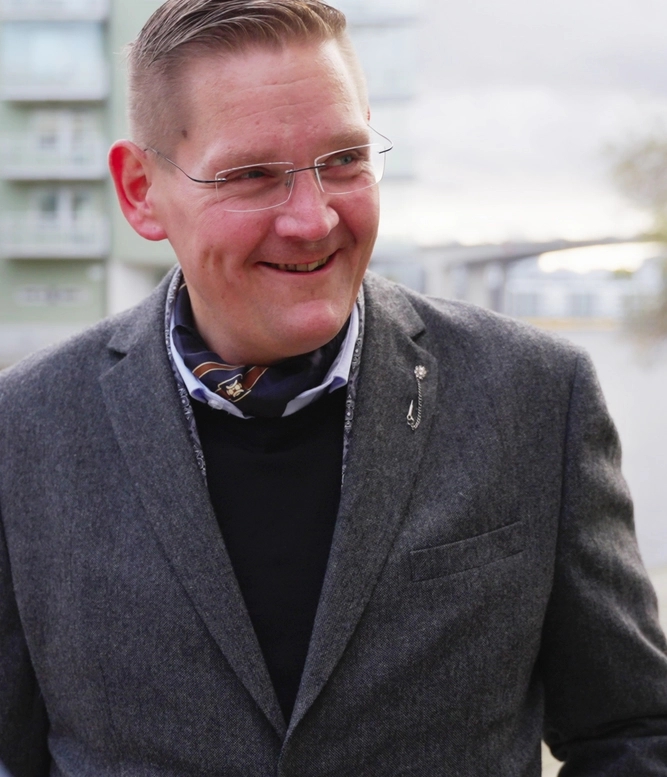opioid dependence
Mattias' story

What started as pain relief became a relentless addiction. Mattias lost his health, career, and trust.
Today, he is rebuilding his life and proving recovery is possible.
From pain relief to dependence – and the path to recovery
In 2008, Mattias became a priest in the Swedish church and moved to Dalarna with his then-wife for his first job. “I loved my work and meeting people on their terms, both in sorrow and joy.” Life was moving at full speed. He was just over 30, had young children, divorced, met a new woman, and was creating a new life with two children and three stepchildren. He was promoted to vicar with personnel and budget responsibilities. At the same time, he started having problems with back pain, so severe that some mornings he could barely get out of bed.
After a doctor’s visit, he was told he had two leaking herniated discs and was prescribed painkillers, Oxycodone, which Mattias later understood were highly addictive. “In the beginning, it was fantastic – the pills took away the pain and helped me perform more, to manage everyday life and be my best both at work and home.”
Within two years, the medication had taken over his life.
“I could work around the clock, and the doctor kept prescribing more and more”, says Mattias.
The life situation became unsustainable, and the doses increased. “We were up to very high doses”, says Mattias. “My body took a toll, I had mood swings, became tired, and could fall asleep in meetings or behind the wheel. My family didn’t recognize me.”
Mattias went to see another doctor: “I left that meeting with a completely new identity – as a second-class person.“ The doctor said the doses were so high that he had to take Mattias’ driver’s license and contact social services.
“It made me feel like an outsider. There was so much shame and guilt. I thought one could handle this on your own; you simply have to pull yourself together and get well.”
The doctor reduced his doses drastically, which did not work. He lost his job, stayed at home, and everything revolved around the hunt for medicine to avoid withdrawal.
“When the body doesn’t get its dose, hell begins. I became a prisoner in my own home, had seizures that resembled epilepsy, lay alone in a dark room, had diarrhea, and vomited. I lost a lot of weight and was a walking skeleton”, he says.
His wife urged him to seek professional help. He ended up in a treatment center but relapsed.
“I tried to throw the tablets away, flush them down the toilet, burn them, do anything to get well. But I couldn’t do it. I fell back again and again”, says Mattias.
Hopelessness set in, and Mattias considered taking his own life. “I thought everyone else would be better off if I didn’t exist”, says Mattias.
When his wife said she could no longer stay in the relationship, Mattias decided to admit himself to ward 65 for addiction patients. There he received information about LARO – medicationassisted treatment for opioid dependence. He began treatment, got effect, which was a strong motivation to continue.

Opioid dependence can affect anyone
Opioid dependence can affect anyone, something Mattias reflected on when in the waiting room for his treatment. “It’s a diverse group sitting in the waiting room, and it’s clear that the disease affects people from all levels in society. You can be anyone, it doesn’t matter. It hits everyone equally.”
Today, Mattias is 42 years old and has been in treatment for 1.5 years. He feels stable and even-tempered.
“I have destroyed everyone’s trust, but now people start to trust me again. I have started rebuilding my social life and personal finances. I am becoming a whole person again.”
Se videos with Mattias sharing his story and his way to recovery at:
Mitt opioidberoende (in Swedish)
Symptoms
In addition to cravings, withdrawals and drug seeking behavior, physical symptoms of opioid dependence may include changes in sleep habits, weight loss and decreased libido.
Diagnosis
An opioid dependence diagnosis may be made by a doctor following a formal assessment based on the patient’s history and pattern of opioid use, such as use of heroin, other illicit opioids or prescription opioids.
Management
Treatment and management of opioid dependence need to be individualized and may consist of a combination of different pharmacological and psychological interventions.
Explore more
Learn more about opioid dependence.